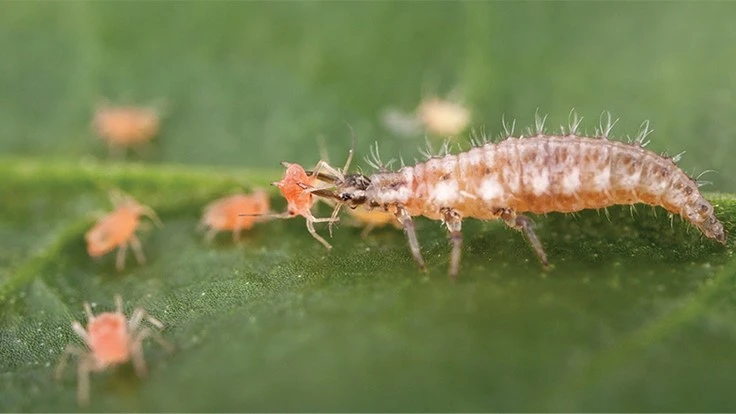

Lloyd Traven had a pest control epiphany 13 years ago, when he delivered some herbs to a garden center and noticed customers popping basil into their mouths. Traven, the owner of Peace Tree Farm in Kintnersville, Pennsylvania, was aghast because he knew what pesticides covered the leaves. It prompted him to explore biological pest control, and he started using predatory and parasitoid insects to quash harmful greenhouse pests.
“Now, we can confidently sell our plants and know there aren’t harmful residues,” says Alex Traven, Lloyd’s son, who joined the family business as head grower in 2014 and oversees the operation’s biocontrol program. “When our plants go into the garden, they’re not covered in chemicals. That’s something people care increasingly about.”
While biocontrols might be an obvious choice for edibles, there are plenty of other reasons why ornamental growers are inviting beneficial bugs into their greenhouses, too.
“There’s a huge cost involved in using pesticides in terms of safety and lost time,” says Traven, citing chemical exposure and long reentry intervals as productivity-killers in any greenhouse. “In addition to that, [pests develop resistance to certain pesticides], so year after year, you’re using new chemicals, and the costs are going up, and it’s getting harder to deal with the same bugs.”
So why not fight back with even better bugs? Follow these tips for kicking off a biological pest control program that will keep unwanted guests out of your greenhouse.
1. Start with a clean slate.
When Lloyd Traven introduced beneficial bugs at Peace Tree, he started with poinsettias. This is a common starting point for many growers venturing into biocontrols, because it allows you to clear out spring crops and start with a clean greenhouse.
“Poinsettias are often a foot in the door for biological controls because they have a fairly limited and predictable pest complex,” Alex Traven says. “And it’s usually at a time of year when growers have more time to focus and experiment.”
You can’t just stop spraying pesticides one day and bring in beneficial bugs the next, because the residues are equally harmful to all bugs. In fact, if you already have pests, it’s probably too late for biocontrols to work their preventative magic — so start fresh with a new crop.
“A biocontrol program starts before your crops are even planted. You need a plan in place,” Traven says. “You need to start with clean plant material and clean growing facilities. Sanitation is key in biocontrol, as it is in regular disease management.”
This approach might seem backwards compared to conventional pest control, because “you lose that hero moment,” Traven explains. “If you have a pest that’s out of control, you spray, and you feel like you saved the day. But with biocontrols, if you do a good job, it’s going to seem like nothing ever happened, because it’s all about proactive prevention rather than treating problems.”
2. Brush up on biology.
Killing pests with chemical sprays is a relatively straightforward equation. But facilitating biological warfare to keep greenhouse crops safe from infestation is a much more complicated interaction, so it’s critical that growers understand who’s involved.
“You don’t need to be an entomologist, but you’ve got to do a little homework,” says Michael Turner, the owner and grower at Sarah & Michael’s Farm in Durham, North Carolina. “You’ve got to know something about the crop you’re growing, the pest you’re targeting and how your beneficial bug works.”
Turner started using biocontrols about two and a half years ago at Sarah & Michael’s Farm, a year-round cut flower farm that primarily produces lilies — because he had difficulty spraying aphids through the tall, thick canopies. He started with “the most universally recommended aphid predator,” the lacewing larvae (Chrysopa).
The lacewings seemed to work at first, but Turner soon “lost total control,” leading to a nasty aphid outbreak. After some investigation, he realized he’d sent the wrong troops to battle. The little Chrysopa crawled around inside the canopy, but never ventured up to the buds where aphids feasted. As soon as he switched to a flying predator like the gall midge (Aphidoletes), Turner’s aphid population dropped.
The lesson is: Get to know your bugs as well as you know your plants. “It’s another living thing for growers to worry about,” Traven says, “but it’s extremely rewarding when it’s working.”
3. Get your people on-board with bugs.
Everyone at Sarah & Michael’s Farm knows when and how Aphidoletes are released, and how to distinguish them from enemy bugs. They know “not to squish the little orange worms,” as they affectionately call the larvae that feed on aphids. This team buy-in is critical, because a biocontrol program requires much bigger commitment than just opening a box of bugs.
“We’re not really trying to kill pests now; we’re trying to grow good bugs,” Turner says, “and that’s a big mind shift. It’s important to have your staff on board with that.”
To get your team to embrace a biocontrol mindset, emphasize the benefits from their perspective. For example, Traven says: “They’re not going to be exposed to as many pesticide residues, they’re not going to have to clear out of working areas for long reentry intervals and they’re not going to have to put on the suit and respirator in the summer heat to spray everything.”
Think beyond your team, too. Once plants hit the market, a few beneficial bugs might tag along, so it’s also important to communicate the presence of these insects to both retail and end consumers. Traven says it’s “an ongoing challenge” to explain biocontrols to retailers, but when the message gets across to end consumers, they’re generally fascinated by the bugs fighting to protect their plants.
“When we tell people how these beneficial insects work, the response is almost across the board: That’s what I want in my garden,” he says. “It’s something that especially younger customers find really cool, so it’s a selling point. It is added value if you can adequately explain it to your customers.”
4. Don’t give up.
Traven says the biggest opponents of biocontrols aren’t the growers who run successful conventional pest control programs — it’s growers who tried using beneficial bugs and failed. Don’t be too quick to grab the sprayer and abort the program before letting nature run its course, he says.
“It’s a really complicated web of interactions, and there are so many variables involved that you need to pay a lot of attention to,” Traven says. “It’s not just something that you can set and forget. You have to be committed.”
It’s certainly not the easiest pest control method, Turner says, but it’s worth the effort.
“It’s more complicated than spraying, so it requires more patience,” Turner says. “You need to commit yourself to the process, be prepared for it not to work sometimes and devote the time to understand what you need to do differently.”
As consumers push for safer, healthier alternatives, they underscore the drive toward biocontrols. In the five years Traven has overseen Peace Tree’s program, he says the market has already expanded significantly — with no slowdown in sight.
“If somebody is reading this who tried 15 years ago and failed and now thinks biocontrol doesn’t work, it might be time to give it another go, because the products and resources available have increased by light years,” Traven says. “We have so many more tools at our disposal to make this system successful.”

Explore the July 2019 Issue
Check out more from this issue and find your next story to read.
Latest from Greenhouse Management
- Anthura acquires Bromelia assets from Corn. Bak in Netherlands
- Top 10 stories for National Poinsettia Day
- Langendoen Mechanical hosts open house to showcase new greenhouse build
- Conor Foy joins EHR's national sales team
- Pantone announces its 2026 Color of the Year
- Syngenta granted federal registration for Trefinti nematicide/fungicide in ornamental market
- A legacy of influence
- HILA 2025 video highlights: John Gaydos of Proven Winners





